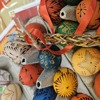The warm rays of the spring sun tickle our faces, the air is filled with the chirping of birds returning from warmer lands, and the first flowers are smiling at us from the grass. In the distant compatriot community in Croatia, colourful melodies of Czech Easter traditions can be heard, thanks primarily to compatriot teachers from Czechia and members of associations called Czech Besedas (České besedy), all driven by their love for Czech roots and a desire to share Czech culture.
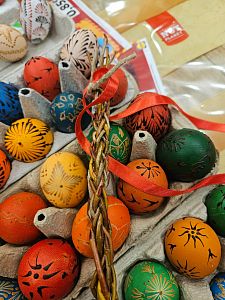 Every year, Easter is celebrated in Croatia with great joy and enthusiasm. This time is associated with traditions, family gatherings, and festive ceremonies. Easter is exceptional for the Czech community in Croatia because it brings together Czech and Croatian cultural richness. Although the traditions in both countries are similar, there are numerous differences that enrich the Easter celebrations in Croatia, intertwining the rich traditions of both nations for over 200 years.
Every year, Easter is celebrated in Croatia with great joy and enthusiasm. This time is associated with traditions, family gatherings, and festive ceremonies. Easter is exceptional for the Czech community in Croatia because it brings together Czech and Croatian cultural richness. Although the traditions in both countries are similar, there are numerous differences that enrich the Easter celebrations in Croatia, intertwining the rich traditions of both nations for over 200 years.
And what Easter customs did the Czechs bring to Croatia?
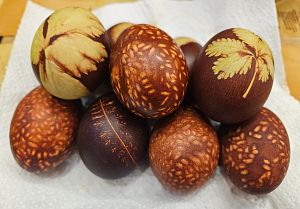 One of the most prominent elements of Czech Easter is decorating Easter eggs. Czech families in Croatia often decorate eggs with wax or dye them using traditional techniques, such as boiling them in onion skin broth. To create beautifully patterned eggs, they add leaves of various shapes or rice, which create interesting imprints.
One of the most prominent elements of Czech Easter is decorating Easter eggs. Czech families in Croatia often decorate eggs with wax or dye them using traditional techniques, such as boiling them in onion skin broth. To create beautifully patterned eggs, they add leaves of various shapes or rice, which create interesting imprints.
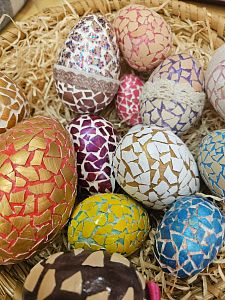 Another unforgettable element of Czech Easter is weaving traditional Easter whips from fresh willow branches. This custom passed down from generation to generation for centuries, still brings smiles to the faces of young and old carolers today. Weaving the whip is a ritual associated with health and has a firm place in the hearts of all Czech compatriots. The origin of weaving the whip dates back to pagan times and was associated with celebrating spring and the renewal of life after a long and dark winter. With the advent of Christianity, this custom was incorporated into Easter celebrations as a symbol of renewal, resurrection, and a new beginning.
Another unforgettable element of Czech Easter is weaving traditional Easter whips from fresh willow branches. This custom passed down from generation to generation for centuries, still brings smiles to the faces of young and old carolers today. Weaving the whip is a ritual associated with health and has a firm place in the hearts of all Czech compatriots. The origin of weaving the whip dates back to pagan times and was associated with celebrating spring and the renewal of life after a long and dark winter. With the advent of Christianity, this custom was incorporated into Easter celebrations as a symbol of renewal, resurrection, and a new beginning.
On Easter Monday, young and old carolers set out with their whips to go carolling. They go from house to house, whipping girls so that they stay healthy and young all year round. Every proper caroler must also recite an Easter poem. As a reward, they receive coloured eggs, sweets, or colourful ribbons for their whip. The colours of the ribbons have their symbolism; for example, red is often associated with love, passion, and courage, green with nature, renewal, and life, and yellow symbolizes happiness, contentment, and abundance.
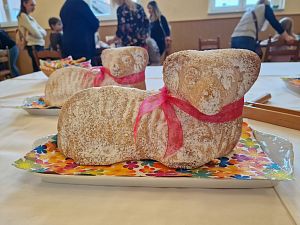 As with any other significant holiday, traditional dishes must not be missing from Easter. Almost every table in a Czech household is adorned with an Easter lamb (beránek), a sweet pastry in the shape of a lamb, baked from flour, sugar, and eggs. The lamb symbolizes the memory of the sacrifice of Jesus Christ, who was pure and innocent like a lamb and sacrificed himself for his people.
As with any other significant holiday, traditional dishes must not be missing from Easter. Almost every table in a Czech household is adorned with an Easter lamb (beránek), a sweet pastry in the shape of a lamb, baked from flour, sugar, and eggs. The lamb symbolizes the memory of the sacrifice of Jesus Christ, who was pure and innocent like a lamb and sacrificed himself for his people.
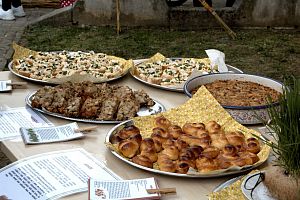 Another indispensable sweet dish is the so-called "mazanec", sun-shaped bread baked from yeast, butter, milk, sugar, and candied fruits. This sweet bread is often flavoured with cinnamon, vanilla, or lemon zest and decorated with raisins or almond flakes. Mazanec has a rich history and is a symbol of abundance and prosperity.
Another indispensable sweet dish is the so-called "mazanec", sun-shaped bread baked from yeast, butter, milk, sugar, and candied fruits. This sweet bread is often flavoured with cinnamon, vanilla, or lemon zest and decorated with raisins or almond flakes. Mazanec has a rich history and is a symbol of abundance and prosperity.
A traditional Easter dish called Judas (jidáše) is named after the biblical figure Judas Iscariot, one of the apostles who betrayed Jesus. The shape of the pastry symbolizes the rope on which Judas hanged himself. Therefore, Judas is most often baked in the shape of a coiled rope as a reminder of his hanging or as Easter loaves.
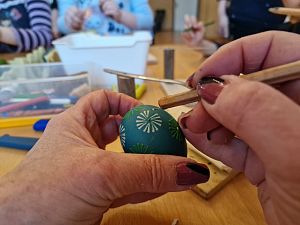 As Czech compatriots, who are well acquainted with these customs and traditions and eagerly look forward to them every year, as well as interested individuals from among the Croats, who are unfamiliar with Czech traditions, had a unique opportunity to try out all these activities and also taste the mentioned traditional Czech dishes.
As Czech compatriots, who are well acquainted with these customs and traditions and eagerly look forward to them every year, as well as interested individuals from among the Croats, who are unfamiliar with Czech traditions, had a unique opportunity to try out all these activities and also taste the mentioned traditional Czech dishes.
Compatriot teachers from Czechia and five Czech Beseda groups joined forces and organized an event called "Skillful Hands for Easter" (Šikovné ruce na Velikonoce). It all played out in the outdoor spaces of the Daruvar City Library, filled with all colours. Participants tried their hand at crocheting traditional Easter motifs, decorated eggs using a technique called decoupage, and also tried their hand at dyeing them using onion skins. The highlight of the whole event could only be weaving the classic whip. All participants learned many new skills but, above all, enjoyed the time spent together, which was full of smiles and joy.

